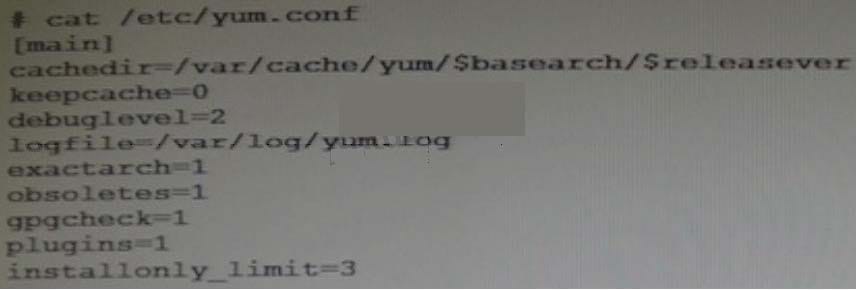Exam Details
Exam Code
:1Z0-460Exam Name
:Oracle Linux 6 Implementation EssentialsCertification
:Oracle CertificationsVendor
:OracleTotal Questions
:71 Q&AsLast Updated
:Jun 20, 2025
Oracle Oracle Certifications 1Z0-460 Questions & Answers
-
Question 11:

What are the two benefits of configuring network interface bonding?
A. aggregating two or more Network Interfaces (NICs) to act as one logical interface
B. creating a static address that is bound to one NIC
C. providing either failover or load-balancing to two or more Network Interfaces (NICs)
D. binding a network interface to the embedded firewall (IPTables) for port filtering
-
Question 12:
Examine the following kernel boot command-line parameters.
kernel /vmlinuz-2.6.32-220.e16 ro root = /dev/VolGroup00/LogVol00 init = /bin/bash ether = 0, 0, eth1 rhgb quiet
Which two statements are true?
A. An unrecognized kernel boot command-line parameter has been used.
B. The system will boot without password.
C. Boot argument ether will force probing for a second ethernet card (NIC).
D. It will not probe for any hard drive.
-
Question 13:
Examine the output of the yum.conf configuration file from o Oracle Linux 6 server.

What does the "installonly_limit=3" option mean?
A. Only three users can use the yum command simultaneously to install package on Oracle Linux 6 server.
B. Only three Linux packages can be installed in one invocation of the yum command.
C. Only three repository channels can be used for installing Linux packages.
D. Only three versions of packages listed in installonlypkgs can be installed simultaneously.
-
Question 14:
Which two commands can be used on Oracle Linux to find the routing table and default gateway information of your network?
A. netstat r
B. route show
C. cat /proc/route
D. route n
E. traceroute
-
Question 15:
The DBA tells you that the system is not overloaded but you can tell that the system us actively swapping. What command would you run to show this information to the DBA?
A. # iotop
B. # iostat 5 10
C. # cat /proc/meminfo
D. # vmstat 5 10
-
Question 16:
You have mounted an Oracle Linux 6 ISO image (v33411-01.iso) on your system in the /mnt/iso/OL6u3/ Server directory. You want to use this image in your local yum repository configuration file and enable it. Which yum repository configuration file has the correct entries to use this image as a local repository?
A. [ol6u3_base_media] name=Oracle Linux 6 Media baseurl=file:///mnt/iso/OL6u3/Server gpgcheck=1 enabled=0
B. [ol6u3_base_media] name=Oracle Linux 6 Media baseurl=file:///mnt/iso/V33411-01.iso gpgcheck=1 enabled=1
C. [ol6u3_base_media] name=Oracle Linux 6 Media baseurl=file:///mnt/iso/OL6u3/Server gpgcheck=1 enabled=1
D. [ol6u3_base_media] name=Oracle Linux 6 Media baseurl=http:///mnt/iso/OL6u3/Server gpgcheck=1 enabled=1
-
Question 17:
Identify the two kernels that are shipped with Oracle Linux 6.
A. Unbreakable Enterprise Kernel
B. Unbeatable Enterprise Kernel 11g
C. Red Hat Compatible Kernel
D. Linux Compatible Kernel
E. Solaris 11 Container Kernel
-
Question 18:
You want to add a README.txt file in the home directory of every new user that you create by using the useradd command on your Oracle Linux system. In which directory will you place the README.txt file so that it automatically gets copied to the new user's home directory when the user is created?
A. /home/users
B. /etc/default/useradd
C. /etc/default
D. /etc/skel
-
Question 19:
A system administrator wants to view all running processes on the system in real time, to find out what RAM has been allocating to each process. What system command should be used?
A. ps ef
B. ps ax
C. top
D. meminfo
-
Question 20:
Which three statements are true about the Kickstart installation method?
A. The Kickstart installation method helps to speed boot time after the system restarts.
B. A Kickstart file is created for every installation.
C. The Kickstart Configurator can be used to create or make changes to a kickstart file.
D. The Kickstart method allows for unattended and more standardized installations.
E. The Kickstart method of configuration is performed after the installation of the host operating system.
Related Exams:
1Z0-020
Oracle8i: New Features for Administrators1Z0-023
Architecture and Administration1Z0-024
Performance Tuning1Z0-025
Backup and Recovery1Z0-026
Network Administration1Z0-034
Upgrade Oracle9i/10g OCA to Oracle Database OCP1Z0-036
Managing Oracle9i on Linux1Z0-041
Oracle Database 10g: DBA Assessment1Z0-052
Oracle Database 11g: Administration Workshop I1Z0-053
Oracle Database 11g: Administration II
Tips on How to Prepare for the Exams
Nowadays, the certification exams become more and more important and required by more and more enterprises when applying for a job. But how to prepare for the exam effectively? How to prepare for the exam in a short time with less efforts? How to get a ideal result and how to find the most reliable resources? Here on Vcedump.com, you will find all the answers. Vcedump.com provide not only Oracle exam questions, answers and explanations but also complete assistance on your exam preparation and certification application. If you are confused on your 1Z0-460 exam preparations and Oracle certification application, do not hesitate to visit our Vcedump.com to find your solutions here.